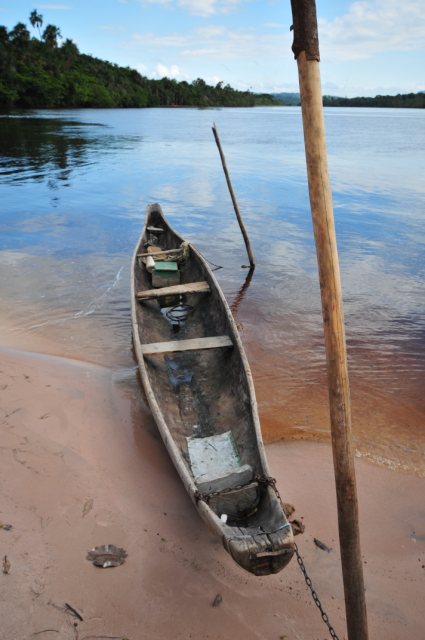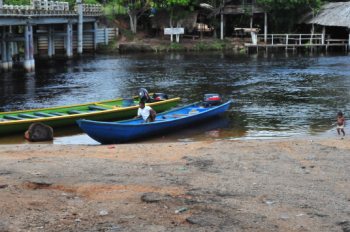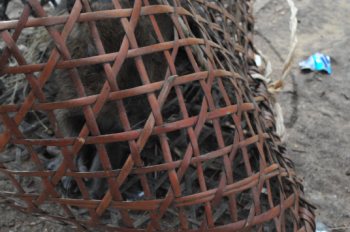Pemon

|
The Pemon Carib Indians of
Venezuela
 The Pemon Carib Indians of Venezuela are a mystery before about 1750 but even in today’s bustle they remain largely unspoilt and live just the way they always have with few luxuries from the outside world. Outboard engines are often seen on the back of their traditional dugout canoes. They trade their beautiful woven baskets for t-shirts. Other names for the people were Arecuna, Kamarakoto, and Taurepan but as they refer to themselves as Pemon the name has become generally used. At the end of the nineteenth century English Protestant missionaries started to Christianise the area. In 1931, the first Capuchin - a Catholic religious order built a missionary post. Gold and diamonds were mined around 1936 and during sixties the area was connected with other parts of Venezuela by aeroplane and a road system. Diamond mining has not been a major activity in recent years. This, together with the poor quality of Pemon agricultural land and the late opening of the area, has spared the Pemon from major land invasions from the outside world. Many of their traditions and their original methods of communication - language, smoke signals and messages carried by people on foot have survived. The Pemon territory covers the coastal area of the Atlantic Ocean in Venezuela, the inland mountain savannah and the Amazon River area. South of the Orinoco River the landscape is mostly lowland, giving way to mountains farther south toward the Amazon region.
In 1943, Father Cesareo de Armellada
published the first dictionary of Pemon language. At the time it was called
Taurepan.
Sugar-cane is kaiwara-kun-ima or
"pineapple with a very long leg."
Pineapple itself, kaiwara,
means "a sweet with wrinkles."
Dew is chirke-yetaku, which means
"star's saliva."
Yetaku or saliva is more precisely, "juice of the teeth."
The day is divided into dawning,
morning, noontime and afternoon, there is no word for year.
The Pemon speak their own language
among themselves, and simplified Spanish with us, the outsiders. In the mission
villages and mining areas of the state of Bolívar, more and more young people
also use Spanish among themselves. Pemon people tend now to have Spanish
Christian names as well as two Amerindian names, one sacred and one secret.
   This monkey
was for sale for 500 Bolivars, about £82, he had a raffia rein tied to a large
stone. Being held by Branko and then
Fred
The Pemon have traditionally believed that each person has five souls, which look like the shadows of a human being. The fifth soul is the one that talks and that leaves the body to travel around when the person is dreaming. This is the only one that goes away - to the Milky Way after death. Before arriving there, it meets the Father of the Dogs. If the person has mistreated his or her dogs, the dogs' souls will recognize the person and kill him or her. One of the other four souls lives in the knee and stays put for a while after death, later, it turns into a bad spirit. The other three souls turn into birds of prey after death. All animals and plants are believed to have souls. Stones have bad spirits but no souls. The Makunaima is a series of creation stories of the land, crops, techniques and social practices. It starts with the creation of a wife for the first Pemon, the Sun, by a water nymph. At that time, the Sun was a person. One day he went to the stream and saw a small woman called Tuekaron who had long hair. He managed to grasp her hair, but she told him, "Not me! I will send you a woman to be your companion and your wife." The next day she sent the Sun a white woman. He fed her, and she lit a fire. But when the Sun sent her to the stream, she collapsed into a little heap of clay. The woman was made of white earth or clay. The next day Tuenkaron sent him a black woman. She was able to bring water, but when she tried to light a fire, she melted. The woman was made of wax. The third woman was red, a rock-coloured woman. The sun tested her and she did not melt or collapse. She was strong and able to help run the household. The woman and the Sun had several children and these are the Pemon people.   
Most Amerindian belief systems have been mixed to some degree with strong Catholic elements, the Pemon still believe in Kanaima, the spirit of evil. Also, some social traditions, such as the marriage of cousins, that are opposed by the church are practiced by many Pemon. The Pemon have also mixed traditional cult saints with Catholic saints. Most major Christian holidays are observed, Easter and Christmas being the most important. Baptism in a Catholic mission is now the only important rite of passage. Traditionally, a boy's passage into adolescence was marked with a special ceremony. A Pemon religious leader lashed a boy's body, making incisions on his skin, then applying magical substances to the wounds. For one year after the ceremony certain foods were not permitted. A girl's passage into adolescence was marked by a haircut before the first menstruation as well as the edges of her mouth was tattooed in a traditional design. At the first sign of menstruation, the girl retired to her hammock and was considered impure. Her grandmother would then paint her whole body in a special way. . Open conflict, anger, and fighting are strongly discouraged. The basic response to conflict is to withdraw. Often this means a person will leave home and make an extended visit to relatives somewhere else, waiting for things to calm down. Since the Pemon do not approve of anger or displays of hostility, physical punishment of their much loved children is very rare, they learn by example, if ever slapped it is more like a tap. They are given much freedom and time to play. Their attitude toward them is lenient, not constantly reminding them about their behaviour. Children learn by following the parents' example and very seldom need to be disciplined or punished. The children we saw all looked happy and contented. In the old days, when somebody became ill, the local shaman or paisan connected the cause of the illness with one of the many mythical spirits. For healing, the shaman uses his taren recipes. These are a mixture of medicinal plants and charms. The taren is believed to be a magic spell that can aid in the birth of a child, counter the bite of various snakes, heal headaches and stomach pains, and so forth. The taren can only be taught to one person at a time, and it is performed in the presence of as few people as possible.
The Pemon's traditional housing consists of huts whose walls are made of clay or bark, with roofs made of palm leaves. Hammocks are hung from the beams of the roof and a fire is kept at one or two corners of the house. Arrows, knives, axes and fishing rods are piled up in another corner. Baskets, carrying sacks and pumpkins hang on the walls.
Marriage is the basis of the main social and economic unit, it determines visits with other villages - the heart of social life. Visits for beer parties and meetings with relatives tie neighbourhoods and regions together. The respect that a village or neighbourhood receives is often gauged by the quality and quantity of manioc (cassava) beer offered by the hosts. Conversation is lively when the family gathers for a meal. If guests are present, the men eat first. The relationship between the father-in-law and the son-in-law is most important. For the father-in-law, his son-in-law is the substitute for his own son. Therefore, after the marriage, the son-in-law detaches himself from his own father and takes care of his father-in-law. In the Pemon society, there is no wedding ceremony. The new husband simply moves his hammock to his father-in-law's house and starts working with him. According to traditional beliefs, the solid parts of babies - the bones come from the father, and the blood comes from the mother. The mother gives birth behind a partition installed in the hut. She is helped by her mother or mother-in-law. For ten days after the birth, the parents stay behind the partition with their newborn child. Pemon used to be naked or wore only loincloths. The women wore an apron made of cotton or beads. In the twentieth century, the men's loincloths were made of a bright red cloth obtained from the criollos - Venezuelans of mixed descent. By 1945 the Pemon had started wearing Western cotton clothing. The men tend to wear khaki, while the women make their dresses using cotton printed fabrics. At the beginning of the twentieth century, the women wore metal earrings known as "butterfly" earrings, which they bought. It was also common for them to have facial tattoos and to wear bands of cotton cloth or glass beads around their arms and legs.
This is the local "butcher", we didn't like to ask what the feet hanging out of the bucket once belonged to. An agouti in the basket ready for sale. Yucca, manioc or cassava root are an important ingredient in the Pemon diet. The women peel, wash and grate this root. They then squeeze out the acid and make it into a dough. With this, they prepare their flat bread or fermented drinks. One of these beverages, the cachiri, is made with bitter yucca paste, which is grated and chewed and mixed with a red root, cachiriyek, also grated. The mixture is then boiled for a whole day and is mildly intoxicating. Also aurosa - a spinach like vegetable. The Pemon eat peppers, potatoes, pineapple, plantain, sugarcane, and more than ten varieties of bananas. Women gather peppers and aurosa daily for the pot soup that forms part of every meal. Fishing provides an important source of protein in their diet. In the past, hunting was not very effective, even though the men put a great deal of time into it. The situation changed, however, with the arrival of firearms in the 1940’s. Birds and mammals, such as deer and vampire bats then became an important part of the diet. During the rainy season, the Pemon capture flying ants. Throughout the year, they gather the insect larvae found in the moriche palm.
One of the tools of the Pemon for educating their young is oral tradition and literature. Their many stories are used by the elders to teach their sense of morality and concept of the world. The storyteller's closing words are usually A-pantoní-pe nichii - May you take advantage of this story, tales and legends are called panton. There is no specific time dedicated to telling stories, but the favourite moment is just before going to sleep. The morning is the time for telling and interpreting dreams, storytelling might happen again after meals. Stories and legends are considered luxuries. People take special trips to visit other groups in order to collect them. The possessor of stories is called sak . A guest who tells stories or brings news or new songs is always welcome. Since 1979, bilingual education at Amerindian primary schools has been compulsory. Most children have at least one school book, The Teachers' Organizations and the Government have proved their good will but, there are many difficulties in keeping up this system. Some children spend time in mission boarding schools or day schools through the primary school years and sometimes longer.
The local school children at base camp
sang and danced for us, they sung in
Pemon and Spanish. We bought a CD which helps toward school
funds.
Music and dance are important components of the Pemon culture. They accompany all sorts of public festivals and rituals. Mari' or Mari'k, is the Pemon word for the dance and music that used to be performed in public by the paisan (shaman) and his assistants. Nowadays there are no paisans left in the Christianised villages. Some Pemon even seem to be ashamed of tokens from their past, such as old musical instruments. Still, on occasions when cachiri drinking makes them receptive to tradition, spontaneously an old dance starts. With sticks and empty tin cans for instruments, they sing songs full of endlessly repeated short phrases, varied by made-up phrases, jokes and bits of the old shaman songs. For the Pemon, work is a basic part of life. There is no word for "working" other than senneka, which means "being active" more than "labouring." Only when the Pemon started working with the missionaries or miners did they adopt the Spanish word trabajo (work), which turned into trabasoman to describe work done in the European way. The Pemon's means of subsistence is based on slash and burn farming, fishing, hunting, collecting wild fruits and insects. There is now more flexibility in the division of work among the Pemon people. Traditionally men were responsible for preparing the soil for planting, while women were in charge of weeding, harvesting and transporting the crops. Spectator sports have never been common among aboriginal peoples. Most of the talents valued by these societies are part of their day to day life like essential survival skills. Fishing, hunting and merely getting from one place to another require the ability to run fast, jump high and far, use the bow and arrow and swim well. Pemon Indians who are in close contact with whites do pay some attention to spectator sports.   
The Pemon value the abilities of their artisans. Anne pleased with her purchases. Outstanding persons are recognised for their individual skills. Some women are famous for the quality of their clay bowls. Basketry is a major art form. Men make all of the baskets and fibre articles, including the eating mats and strainers used in everyday household work and cooking. Everyday basketry is different from the more complicated forms, which can be used in trade. As in the case of pottery, only certain men are skilled at making complex baskets. The Pemon also make wooden dugout and bark canoes, paddles and bows, they weave hammocks and baby carriers.
Authorities and international support organizations identified land rights as the most pressing issue facing the Pemon in the 1990’s. Venezuela recognises land rights for its Amerindian population. But in many cases it provides only provisional titles to land, which can be ignored easily. Gold, diamonds and timber are once again attracting outsiders. Their arrival often leads to violation of Indian rights. The tourist industry is also threatening the region. What has been a controlled, eco-friendly enterprise could turn into an invasion if plans to build big hotels are approved. We can only hope that this never happens.
ALL IN ALL THIS FIRST EXPERIENCE WITH
A SUCH AN UNSPOILT PEOPLE WAS VERY SPECIAL
QUITE SURPRISING IN THAT THEY LOOKED SOMEWHAT
MONGOLIAN TO ME
|












